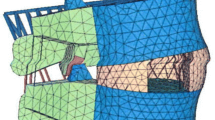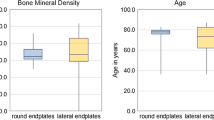Abstract
Introduction
Expandable titanium implants for vertebral body replacement in the thoracolumbar spine have been well established in the reconstruction of the anterior spinal column. Load transfer at the bone-implant interface remains a point of concern. The purpose of the study was to compare the performance in axial load transfer from the implant to the vertebral body in four different implants, all of them in clinical use to date.
Materials and methods
We tested a second generation implant (Synex II) in comparison to three different expandable titanium cages: Synex I, Obelisc and X-Tenz. Twenty-four intact fresh frozen human lumbar vertebrae (L1–L4) were distributed into four identical groups according to bone mineral density (BMD). The BMD was determined by quantitative computed tomography (qCT). Specimens were loaded in craniocaudal direction with a material testing machine (Mini Bionix II) at a constant speed of 5 mm/min. Load displacement curves were continuously recorded for each specimen until failure (diminishment of compressive force (F) and/or obvious implant migration through the vertebral body end plate). One-way analysis of variance (ANOVA) and post-hoc tests (Bonferroni) were applied to detect differences at 1, 2, 3, and 4 mm displacement (F 1–4 mm) between implant groups.
Result
No significant differences were observed with regard to maximum compression force (F max) and displacement (d max) until failure: Synex II (1,782.3 N/4.67 mm); Synex I (1,645.3 N/4.72 mm); Obelisc (1,314.0 N/4.24 mm); X-Tenz (1470.3 N/6.92 mm). However, the mean compression force at 1–4 mm displacement (F 1–4 mm: 300–1,600 N) was highest for Synex II. The difference at 2 mm displacement was significant (p = 0.028) between Synex II (F 2 mm = 879 N) and X-Tenz (F 2 mm = 339 N).
Conclusion
The modified end plate design of Synex II was found to perform comparably at least with regard to the compressive performance at the implant-bone interface. The risk of the new implant for collapse into the vertebral body might be reduced when compared to the competitors.





Similar content being viewed by others
References
Andersson GB, Örtengren R, Nachemson A (1977) Intradiscal pressure, intraabdominal pressure and myoelectric back muscle activity related to posture and loading. Clin Orthop Relat Res 129:156–164
Banwart JC, Asher MA, Hassanein RS (1995) Iliac crest bone graft harvest donor site morbidity: a statistical evaluation. Spine 20(9):1055–1060. doi:10.1097/00007632-199505000-00012
Beisse R, Potulski M, Beger J, Buhren V (2002) Development and clinical application of a thoracoscopy implantable plate frame for treatment of thoracolumbar fractures and instabilities. Orthopade 31(4):413–422. doi:10.1007/s00132-001-0285-6
Beisse R, Potulski M, Temme C, Buhren V (1998) Endoscopically controlled division of the diaphragm: a minimally invasive approach to ventral management of thoracolumbar fractures of the spine. Unfallchirurg 101(8):619–627. doi:10.1007/s001130050315
Bergot C, Laval-Jeantet AM, Hutchinson K, Dautraix I, Caulin F, Genant HK (2001) A comparison of spinal quantitative computed tomography with dual energy X-ray absorptiometry in European women with vertebral and nonvertebral fractures. Calcif Tissue Int 68(2):74–82. doi:10.1007/BF02678144
Blauth M, Knop C, Bastian L, Lobenhoffer P (1997) New developments in surgery of the injured spine. Orthopade 26(5):437–449
Closkey RF, Parsons JR, Lee CK, Blacksin MF, Zimmerman MC (1993) Mechanics of interbody spinal fusion: analysis of critical bone graft area. Spine 18(8):1011–1015. doi:10.1097/00007632-199306150-00010
Goel VK, Wilder DG, Pope MH, Edwards WT (1995) Biomechanical testing of the spine: load-controlled versus displacement-controlled analysis. Spine 20(21):2354–2357. doi:10.1097/00007632-199511000-00017
Goldhahn J, Reinhold M, Stauber M, Frei R, Schneider E, Linke B (2006) Improved anchorage in osteoporotic vertebrae with new implant designs. J Orthop Res (in press)
Goulet JA, Senunas LE, DeSilva GL, Greenfield ML (1997) Autogenous iliac crest bone graft: complications and functional assessment. Clin Orthop Relat Res 339:76–81. doi:10.1097/00003086-199706000-00011
Hansson T, Roos B (1981) The relation between bone mineral content, experimental compression fractures, and disc degeneration in lumbar vertebrae. Spine 6(2):147–153. doi:10.1097/00007632-198103000-00007
Hansson T, Roos B, Nachemson A (1980) The bone mineral content and ultimate compressive strength of lumbar vertebrae. Spine 5(1):46–55. doi:10.1097/00007632-198001000-00009
Hollowell JP, Vollmer DG, Wilson CR, Pintar FA, Yoganandan N (1996) Biomechanical analysis of thoracolumbar interbody constructs: how important is the endplate? Spine 21(9):1032–1036. doi:10.1097/00007632-199605010-00007
Huang TJ, Hsu RW, Sum CW, Liu HP (1999) Complications in thoracoscopic spinal surgery: a study of 90 consecutive patients. Surg Endosc 13(4):346–350. doi:10.1007/s004649900987
James KS, Wenger KH, Schlegel JD, Dunn HK (1994) Biomechanical evaluation of the stability of thoracolumbar burst fractures. Spine 19(15):1731–1740. doi:10.1097/00007632-199408000-00013
Jost B, Cripton PA, Lund T, Oxland TR et al (1998) Compressive strength of interbody cages in the lumbar spine: the effect of cage shape, posterior instrumentation and bone density. Eur Spine J 7(2):132–141. doi:10.1007/s005860050043
Junghanns H (1955) Wirbelsäule. In: Buerkle de la Camp H, Rostock P (eds) Handbuch der gesamten Unfallchirurgie, Band Bd. II. Enke, Stuttgart, pp 520–564
Kandziora F, Pflugmacher R, Schaefer J, Scholz M et al (2003) Biomechanical comparison of expandable cages for vertebral body replacement in the cervical spine. J Neurosurg 99(1 Suppl):91–97
Karches C, Friedl W (2002) Secondary dislocations after Synex Cage implantation. Unfallchirurg 105(8):744–747. doi:10.1007/s00113-002-0426-3
Knop C, Blauth M, Buhren V, Arand M et al (2001) Operative Behandlung von Verletzungen des thorakolumbalen Überganges—Teil 3: Nachuntersuchung. Unfallchirurg 104(7):583–600. doi:10.1007/s001130170089
Knop C, Fabian HF, Bastian L, Rosenthal H et al (2002) Fate of the transpedicular intervertebral bone graft after posterior stabilisation of thoracolumbar fractures. Eur Spine J 11(3):251–257. doi:10.1007/s00586-001-0360-z
Knop C, Lange U, Bastian L, Blauth M (2000) Three-dimensional motion analysis with Synex: comparative biomechanical test series with a new vertebral body replacement for the thoracolumbar spine. Eur Spine J 9(6):472–485. doi:10.1007/s005860000185
Knop C, Lange U, Bastian L, Oeser M, Blauth M (2001) Biomechanical compression tests with a new implant for thoracolumbar vertebral body replacement. Eur Spine J 10(1):30–37. doi:10.1007/s005860000211
Knop C, Lange U, Reinhold M, Blauth M (2005) Vertebral body replacement with Synex in combined posteroanterior surgery for treatment of thoracolumbar injuries. Oper Orthop Traumatol 17(3):249–280. doi:10.1007/s00064-005-1132-4
Lange U, Knop C, Bastian L, Blauth M (2003) Prospective multicenter study with a new implant for thoracolumbar vertebral body replacement. Arch Orthop Trauma Surg 123(5):203–208
Lowery GL, Harms J (1996) Titanium surgical mesh for vertebral defect replacement and intervertebral spacers. In: Thalgott J, Aebi M (eds) Manual of internal fixation of the spine. Lippincott & Raven, Philadelphia, pp 127–146
Lund T, Oxland TR, Jost B, Cripton P et al (1998) Interbody cage stabilisation in the lumbar spine: biomechanical evaluation of cage design, posterior instrumentation and bone density. J Bone Joint Surg Br 80(2):351–359. doi:10.1302/0301-620X.80B2.7693
McBroom RJ, Hayes WC, Edwards WT, Goldberg RP, White AAIII (1985) Prediction of vertebral body compressive fracture using quantitative computed tomography. J Bone Joint Surg Am 67(8):1206–1214
Nachemson AL (1981) Disc pressure measurements. Spine 6(1):93–97. doi:10.1097/00007632-198101000-00020
Panjabi MM (1988) Biomechanical evaluation of spinal fixation devices: I. A conceptual framework. Spine 13(10):1129–1134
Pflugmacher R, Schleicher P, Schaefer J, Scholz M et al (2004) Biomechanical comparison of expandable cages for vertebral body replacement in the thoracolumbar spine. Spine 29(13):1413–1419. doi:10.1097/01.BRS.0000129895.90939.1E
Plaue R (1972) Behavior of thoracic and lumbar vertebral fractures: 1. Compression experiments on macerated vertebral bodies. Z Orthop Ihre Grenzgeb 110(2):159–166
Reinhold M, Schmid R, Knop C, Blauth M (2004) Komplikationsspektrum operativ versorgter Wirbelsäulenverletzungen—Eine Analyse der Multicenterstdien I und II der AG Wirbelsäule [Spectrum of complications involved in surgical management of spinal injuries—analysis of two multicenter studies]. Trauma und Berufskrankheit
Reinhold M, Schwieger K, Goldhahn J, Linke B, Knop C, Blauth M (2006) Influence of screw positioning in a new anterior spine fixator on implant loosening in osteoporotic vertebrae—a biomechanical in vitro Study. Spine 31(4):406–413. doi:10.1097/01.brs.0000199894.63450.70
Rockoff SD, Sweet E, Bleustein J (1969) The relative contribution of trabecular and cortical bone to the strength of human lumbar vertebrae. Calcif Tissue Res 3(2):163–175. doi:10.1007/BF02058659
Rohlmann A, Claes LE, Bergmannt G, Graichen F, Neef P, Wilke HJ (2001) Comparison of intradiscal pressures and spinal fixator loads for different body positions and exercises. Ergonomics 44(8):781–794. doi:10.1080/00140130110047657
Sato K, Kikuchi S, Yonezawa T (1999) In vivo intradiscal pressure measurement in healthy individuals and in patients with ongoing back problems. Spine 24(23):2468–2474. doi:10.1097/00007632-199912010-00008
Schnee CL, Freese A, Weil RJ, Marcotte PJ (1997) Analysis of harvest morbidity and radiographic outcome using autograft for anterior cervical fusion. Spine 22(19):2222–2227. doi:10.1097/00007632-199710010-00005
Schultz AB, Andersson GB, Örtengren R, Haderspeck K, Nachemson A (1982) Loads on the lumbar spine: validation of a biomechanical analysis by measurements of intradiscal pressure and myoelectric signals. J Bone Joint Surg Am 64:713–720
Stoltze D, Harms J (1999) Correction of posttraumatic deformities: principles and methods. Orthopade 28(8):731–745
von Gumppenberg S, Vieweg J, Claudi B, Harms J (1991) Primary management of fresh injuries of the thoracic and lumbar vertebrae. Aktuelle Traumatol 21(6):265–273
Whitesides TE (1977) Traumatic kyphosis of the thoracolumbar spine. Clin Orthop Relat Res 128:78–92
Wilke HJ, Kemmerich V, Claes LE, Arand M (2001) Combined anteroposterior spinal fixation provides superior stabilisation to a single anterior or posterior procedure. J Bone Joint Surg Br 83(4):609–617. doi:10.1302/0301-620X.83B4.9072
Wilke HJ, Neef P, Caimi M, Hoogland T, Claes LE (1999) New in vivo measurements of pressures in the intervertebral disc in daily life. Spine 24(8):755–762. doi:10.1097/00007632-199904150-00005
Wilke HJ, Wenger K, Claes L (1998) Testing criteria for spinal implants: recommendations for the standardization of in vitro stability testing of spinal implants. Eur Spine J 7(2):148–154. doi:10.1007/s005860050045
Wippermann BW, Schratt HE, Steeg S, Tscherne H (1997) Complications of spongiosa harvesting of the ilial crest: a retrospective analysis of 1,191 cases. Chirurg 68(12):1286–1291. doi:10.1007/s001040050361
Wittenberg RH, Moeller J, Shea M, White AAIII, Hayes WC (1990) Compressive strength of autologous and allogenous bone grafts for thoracolumbar and cervical spine fusion. Spine 15(10):1073–1078. doi:10.1097/00007632-199015100-00017
Woiciechowsky C (2005) Distractable vertebral cages for reconstruction after cervical corpectomy. Spine 30(15):1736–1741. doi:10.1097/01.brs.0000172158.31437.ce
Wolfinbarger L Jr, Zhang Y, Adam BL, Sutherland V, Gates K, Brame B (1994) A comprehensive study of physical parameters, biomechanical properties, and statistical correlations of iliac crest bone wedges used in spinal fusion surgery: II. Mechanical properties and correlation with physical parameters. Spine 19(3):284–295
Author information
Authors and Affiliations
Corresponding author
Rights and permissions
About this article
Cite this article
Reinhold, M., Schmoelz, W., Canto, F. et al. A new distractable implant for vertebral body replacement: biomechanical testing of four implants for the thoracolumbar spine. Arch Orthop Trauma Surg 129, 1375–1382 (2009). https://doi.org/10.1007/s00402-009-0823-y
Received:
Published:
Issue Date:
DOI: https://doi.org/10.1007/s00402-009-0823-y




